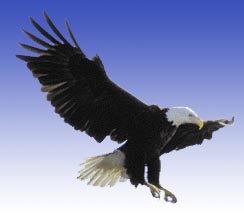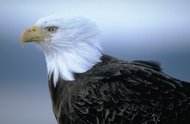Bald Eagle - January 2003 Species of the Month

|
The Bald Eagle
(Haliaeetus leucocephalus) was January's Species
of the Month in honor of the 30th Anniversary of the New Jersey Endangered
Species Conservation Act and the formation of DEP's Endangered
and Nongame Species Program (ENSP).
After being decimated by poor reproduction due to pollution, New Jersey's
bald eagle population has been growing each year since the late 1980s. At
that time, there was just one active nest remaining. The state gained its
second nest in 1988, and the population has been growing ever since, thanks
to ENSP's reintroduction efforts in the 1980s and annual management. |
|
Bald Eagles: New Jersey's Success Story
- The Division of Fish and Wildlife began
to implement strategies to help the bald eagle population in 1982,
after decades of impacts from hunting and pesticide use.
- In 2003, volunteers counted 137 bald eagles
during the State’s annual Mid-Winter Bald Eagle Survey (fewer
than 10 were observed in 1978).
- The number of known breeding pairs in New
Jersey rose from one in 1982 to 34 in 2002.
|

|
 |
|
Bald Eagle Facts of Interest
- Eagles are at the top of the food chain,
which makes them vulnerable to toxic chemicals in the environment.
- Eagles consume fish, small mammals, waterfowl
and dead animal matter.
- Bald eagle habitat consists of forest associated
with bodies of water.
- The average lifespan of an eagle is fifteen
to twenty years or longer.
- The bald eagle was selected as the National
emblem in 1782.
|
|
| Additional
Sources of Information |
|
|
|